NASA’s newest visitor to the Red Planet, the Mars Reconnaissance Orbiter, is still in the process of shrinking its orbit, enroute to its final science orbit. When the spacecraft first arrived, its farthest point from the planet was 45,000 kilometers (28,000 miles). After 11 weeks of aerobraking operations, it’s reduced this distance to about 20,000 km (12,000 miles). Controllers estimate that the spacecraft will still need to sweep through Mars atmosphere 400 more times over the next 12 weeks to complete its orbital maneuvers. Its final mapping orbit will be approximately 255 to 320 km (160 to 200 mi) above the Martian surface.
Continue reading “Mars Reconnaissance Orbiter Continues to Lower its Orbit”
Fast Moving New Horizons Tracks an Asteroid
Still a decade away from its final meeting with Pluto, New Horizons tested out its instruments on a relatively nearby asteroid. The spacecraft turned its Multispectral Visible Imaging Camera (MVIC) on asteroid 2002 JF56 at a range of 1.34 to 3.36 million kilometers (about 833,000 to 2.1 million miles). Controllers were happy to see that the camera system was able to track the asteroid while the spacecraft was moving so quickly; it’ll need this capability when it reaches Pluto. Its next stop will be Jupiter, which it’s due to encounter on February 28, 2007.
Continue reading “Fast Moving New Horizons Tracks an Asteroid”
Genesis Accident Report Released
On the morning of September 8, 2004, NASA scientists were elated. Their Genesis spacecraft had traveled 32 million kilometers (20 million miles), and was loaded up with precious samples of the solar wind and interstellar particles. But as the spacecraft hurtled through the Earth’s atmosphere, it quickly became clear something was very wrong. Instead of floating gently down to Earth on its parachutes, Genesis cratered into the ground at high speed, and its fragile cargo suffered devastating damage. What went wrong? A special Mishap Board released their findings today.
Continue reading “Genesis Accident Report Released”
SOHO Mission Extended Through 2009
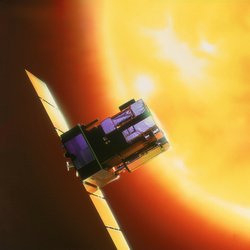
Artist illustration of SOHO and the Sun. Image credit: ESA. Click to enlarge
NASA and ESA’s long-running Solar and Heliospheric Observatory (SOHO) has been given another mission extension, this time until December 2009. The spacecraft was launched on December 2, 1995, and it has been steadily observing the Sun ever since. Over the next two years, five additional spacecraft will join SOHO to observe the Sun. ESA is involved in two of these spacecraft: Solar B, and Proba-2. NASA will launch the STEREO pair of spacecraft, as well as the Solar Dynamics Orbiter in 2008.
New funding, to extend the mission of ESA’s venerable solar watchdog SOHO, will ensure it plays a leading part in the fleet of solar spacecraft scheduled to be launched over the next few years.
Since its launch on 2 December 1995, The Solar and Heliospheric Observatory (SOHO) has provided an unprecedented view of the Sun – and not just the side facing the Earth. Two teams have now developed techniques for using SOHO to recreate the conditions on the far side of the Sun. The new funding will allow its mission to be extended from April 2007 to December 2009.
Despite being over ten years old now, SOHO just keeps on working, monitoring the activity on the Sun and allowing scientists to see inside the Sun by recording the seismic waves that ripple across the surface of our nearest star.
More than 2300 scientists have used data from the solar observatory to forward their research, publishing over 2400 scientific papers in peer-reviewed journals. During the last two years, at least one SOHO paper has been accepted for publication every working day.
“This mission extension will allow SOHO to cement its position as the most important spacecraft in the history of solar physics,” says Bernhard Fleck, SOHO’s project scientist, “There is a lot of valuable work for this spacecraft still to do.”
During the next two years, five new solar spacecraft will join SOHO in orbit. ESA is involved in two of these spacecraft. The Japan Aerospace Exploration Agency (ISAS/JAXA) has built Solar B and will launch it later this year. ESA will supply the use of a ground station at Svalbard, Norway in exchange for access to the data.
Next year, ESA will launch Proba-2, a technology demonstration satellite that carries solar instruments. In particular, it will carry a complementary instrument to SOHO’s EIT camera. Whilst EIT concentrates on the origin and early development of solar eruptions, Proba-2’s camera will be able to track them into space.
NASA plans to launch the STEREO pair of spacecraft later this year, and the Solar Dynamics Orbiter in 2008. Far from making SOHO obsolete, these newer solar satellites embrace it as a crucial member of the team. SOHO will provide a critical third point of view to assist the analysis of STEREO’s observations. Also, SOHO’s coronagraph will remain unique. The instrument is capable of blotting out the glare from the Sun so that the tenuous outer atmosphere of the Sun is visible for study.
“By next year, we will have a fleet of spacecraft studying the Sun,” says Hermann Opgenoorth, Head of Solar System Missions Division at ESA. This will advance the International Living With a Star programme (ILWS), an international collaboration of scientists dedicated to a long-term study of the Sun and its effects on Earth and the other solar system planets.
ILWS will possibly culminate in the launch of the advanced ESA satellite, Solar Orbiter, around 2015. It is designed to travel close to the Sun, to gain a close-up look at the powerful processes at the heart of our Solar System.
Original Source: ESA News Release
“Lucky” Cluster Spacecraft Buffeted by the Solar Wind
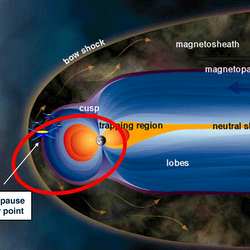
Sketch of the different regions in of Earth’s magnetosphere. Image credit: ESA. Click to enlarge
ESA’s Cluster spacecraft were in the right place at the right time when they flew through a region of the Earth’s magnetic field that accelerates electrons to approximately 1/100th the speed of light. The region is called the electron diffusion region; a boundary just a few kilometres thick between the Earth’s magnetic field and the Sun’s. Over the course of an hour, the spacecraft were engulfed in an electron diffusion region, as the solar wind was causing this layer to move back and forth.
ESA’s Cluster satellites have flown through regions of the Earth’s magnetic field that accelerate electrons to approximately one hundredth the speed of light. The observations present Cluster scientists with their first detection of these events and give them a look at the details of a universal process known as magnetic reconnection.
On 25 January 2005, the four Cluster spacecraft found themselves in the right place at the right time: a region of space known as an electron diffusion region. It is a boundary just a few kilometres thick that occurs at an altitude of approximately 60 000 kilometres above the Earth’s surface. It marks the frontier between the Earth’s magnetic field and that of the Sun. The Sun’s magnetic field is carried to the Earth by a wind of electrically charged particles, known as the solar wind.
An electron diffusion region is like an electrical switch. When it is flipped, it uses energy stored in the Sun’s and Earth’s magnetic fields to heat the electrically charged particles in its vicinity to large speeds. In this way, it initiates a process that can result in the creation of the aurora on Earth, where fast-moving charged particles collide with atmospheric atoms and make them glow.
There is also a more sinister side to the electron diffusion regions. The accelerated particles can damage satellites by colliding with them and causing electrical charges to build up. These short circuit and destroy sensitive equipment.
Nineteen times in one hour, the Cluster quartet found themselves engulfed in an electron diffusion region. This was because the solar wind was buffeting the boundary layer, causing it to move back and forth. Each crossing of the electron diffusion region lasted just 10-20 milliseconds for each spacecraft and yet a unique instrument, known as the Electron Drift Instrument (EDI), was fast enough to measure the accelerated electrons.
The observation is important because it provides the most complete measurements yet of an electron diffusion region. “Not even the best computers in the world can simulate electron diffusion regions; they just don’t have the computing power to do it,” says Forrest Mozer, University of California, Berkeley, who led the investigation of the Cluster data.
The data will provide invaluable insights into the process of magnetic reconnection. The phenomenon occurs throughout the Universe on many different scales, anywhere there are tangled magnetic fields. In these complex situations, the magnetic fields occasionally collapse into more stable configurations. This is the reconnection and releases energy through electron diffusion regions. On the Sun, magnetic reconnection drives the solar flares that occasionally release enormous amounts of energy above sunspots.
This work may also have an important bearing on solving energy needs on Earth. Nuclear physicists trying to build fusion generators attempt to create stable magnetic fields in their reactors but are plagued by reconnection events that ruin their configurations. If the process of reconnection can be understood, perhaps ways of preventing it in nuclear reactors will become clear.
However, that still lies in the future. “We need to do a lot more science before we fully understand reconnection,” says Mozer, whose aim is now to understand which solar wind conditions trigger the reconnection events and their associated electron diffusion regions seen by Cluster.
Original Source: ESA Portal
Dawn Returns from Cancellation
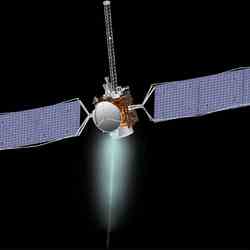
An artist’s illustration of Dawn spacecraft. Image credit: NASA Click to enlarge
Until last week, prospects for the Dawn mission looked bleak. This is a mission designed to send a spacecraft to visit two of the largest asteroids in the Solar System: Ceres and Vesta. The mission had been cancelled on March 2nd, citing technical problems and cost overruns. But NASA managers announced today that Dawn has been reinstated. The project team was able to convince the review board that the technical issues can be solved. The projected launch date has been pushed back a year, however, to July 2007.
NASA senior management announced a decision Monday to reinstate the Dawn mission, a robotic exploration of two major asteroids. Dawn had been canceled because of technical problems and cost overruns.
The mission, named because it was designed to study objects dating from the dawn of the solar system, would travel to Vesta and Ceres, two of the largest asteroids orbiting the sun between Mars and Jupiter. Dawn will use an electric ion propulsion system and orbit multiple objects.
The mission originally was approved in December 2001 and was set for launch in June 2006. Technical problems and other difficulties delayed the projected launch date to July 2007 and pushed the cost from its original estimate of $373 million to $446 million. The decision to cancel Dawn was made March 2, 2006, after about $257 million already had been spent. An additional expenditure of about $14 million would have been required to terminate the project.
The reinstatement resulted from a review process that is part of new management procedures established by NASA Administrator Michael Griffin. The process is intended to help ensure open debate and thorough evaluation of major decisions regarding space exploration and agency operations.
“We revisited a number of technical and financial challenges and the work being done to address them,” said NASA Associate Administrator Rex Geveden, who chaired the review panel. “Our review determined the project team has made substantive progress on many of this mission’s technical issues, and, in the end, we have confidence the mission will succeed.”
The Dawn decision document will be available on the Web at: http://www.nasa.gov/formedia
Original Source: NASA News Release
Night of the Living Dead… Stars
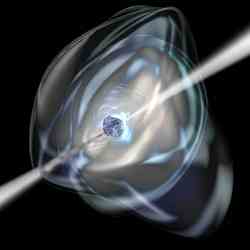
Artist’s view of an X-ray pulsar as seen by Integral. Image credit: NASA Click to enlarge
Like the shambling monsters in a zombie movie, the corpses of dead stars might have a little fight left in them after all. ESA’s Integral spacecraft has been analyzing some anomalous X-ray pulsars, which are thought to be neutron stars with powerful X-ray beams that regularly sweep past the Earth. Integral confirmed that these pulsars have magnetic fields billions of times stronger than anything created here on Earth.
Tiny stellar ‘corpses’ have been caught blasting surprisingly powerful X-rays and gamma rays across our galaxy by ESA’s gamma-ray observatory Integral.
This discovery links these objects to the most magnetically active bodies in the Universe and forces scientists to reconsider just how dead such stellar corpses really are.
Known as anomalous X-ray pulsars (AXPs), the stellar corpses were first spotted pulsing low-energy X-rays into space during the 1970s by the Uhuru X-ray satellite. AXPs are extremely rare with only seven known to exist. The X-rays were first thought to be produced by matter falling from a companion star onto the AXP.
An alternative was that each AXP is the spinning core of a dead star, known as a neutron star, sweeping beams of energy through space like a cosmic lighthouse. When these beams cross Earth?s line of sight, the AXP blinks on and off.
However, this scenario required the AXP’s magnetic field to be a thousand million times stronger than the strongest steady magnetic field achievable in a laboratory on Earth. Nevertheless, the Integral observations show that the magnetic solution is correct.
The newly detected emission, known to astronomers as a ‘hard tail’, of high-energy (‘hard’) X-rays and gamma rays also comes in the form of regular pulses every 6?12 seconds depending upon which AXP is observed.
Discovered in three of the four AXPs studied, the hard tails have a distinctive energy signature that forces astronomers to consider that they are produced by super-strong magnetic fields.
“The amount of energy in the hard tail is ten to almost one thousand times more than can be explained by a kind of magnetic friction between the spinning AXP and surrounding space,” said Wim Hermsen of SRON, the Netherlands Institute for Space Research, Utrecht, who together with SRON colleagues made the observations. This leaves so-called ‘magnetic field decay’ as the only viable alternative.
Neutron stars with super-strong magnetic fields are dubbed ‘magnetars’. Created from the core of a gigantic star that has exploded at the end of its life, each magnetar is only around 15 kilometres in diameter yet contains more than one and a half times the mass of the Sun.
Magnetars are also responsible for the ‘soft gamma-ray repeaters’ (SGRs), which explosively release massive quantities of energy when catastrophic reorganisations of their magnetic fields spontaneously take place. The big difference between an SGR and an AXP is that the process is continuous rather than explosive in an AXP and less energetic.
“Somehow these objects are tapping the enormous magnetic energy contained beneath their surfaces and funnelling it into space,” said Hermsen.
Exactly how that happens is the focus of future work. It is possible that SGRs, of which five are known, turn into AXPs once they have exploded enough of their energy into space.
All known AXPs except one are clustered towards the plane of our galaxy, the Milky Way, indicating that they are the result of recent stellar explosions; some are even wreathed in the exploded gaseous remnants of their former stars.
The other known AXP is in a satellite galaxy of the Milky Way. The hard tails were discovered by Integral serendipitously, thanks to its unique wide-field camera, the Imager on-Board Integral Satellite (IBIS).
“This is one of the things you hope for when you run an observatory like Integral,” said Christoph Winkler, ESA’s Integral project scientist. As the AXPs prove, the stellar afterlife is more alive than astronomers once thought.
Original Source: ESA Portal
CryoSat-2 Will be Constructed
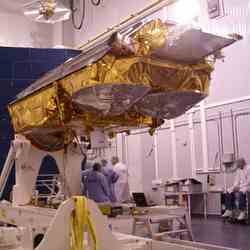
First CryoSat satellite during launch campaign. Image credit: ESA Click to enlarge
At the latest meeting of the European Space Agency’s Earth Observation Programme Board, which took place at ESA’s Headquarters in Paris on 23 and 24 February, ESA received the green light from its Member States to build and launch a CryoSat recovery mission, CryoSat-2.
The launch of the CryoSat spacecraft was unfortunately aborted on 8 October 2005 due to a malfunction of its Rockot launcher, which resulted in the total loss of the spacecraft.
“This decision is very important, as the scientific community in Europe and elsewhere is eagerly awaiting resumption of the CryoSat mission. We are happy to have obtained approval today”, said Volker Liebig, ESA Director of Earth observation programmes.
A CryoSat recovery plan was presented to the Programme Board by ESA’s Executive, which explained the status of ongoing activities and outlined the preparatory work leading to a CryoSat-2 mission, expected to be launched in March 2009.
CryoSat-2 will have the same mission objectives as the original CryoSat mission; it will monitor the thickness of land ice and sea ice and help explain the connection between the melting of the polar ice and the rise in sea levels and how this is contributing to climate change.
The positive decision on CryoSat-2 will allow rational use to be made of the technical and industrial competences for the original mission, as well as best use of the ground segment facilities and operational setup planned for that first mission. It means that the pre-launch scientific validation campaigns over land ice and sea ice can resume with the support of national institutes.
Original Source: ESA Portal
Stardust’s Samples Under Analysis
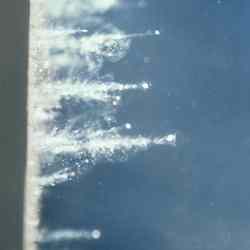
Stardust’s aerogel sample. Image credit: NASA Click to enlarge
Scientists at the University of Chicago are among the first ever to analyze cometary dust delivered to Earth via spacecraft.
Scientists routinely examine extraterrestrial material that has fallen to Earth as meteorites, but never before NASA’s Stardust mission have they had access to verified samples of a comet. The leftover debris from the formation of the solar system 4.5 billion years ago, comets consist mostly of ice, dust and rock.
“We think comets make up a huge amount of stuff out in the solar system. We’d like to know the mineral composition of this big component of the solar system that we’ve never seen before for sure,” said Lawrence Grossman, Professor in Geophysical Sciences. “Various particles have been measured that have been inferred to be from comets, but nobody’s sure. This would finally provide some ground truth.”
Grossman and Steven Simon, Senior Research Associate in Geophysical Sciences, are members of the Stardust Preliminary Examination Team (PET). So are Andrew Davis, Senior Scientist in the Enrico Fermi Institute, and his colleagues Michael Pellin and Michael Savina of the U.S. Department of Energy’s Argonne National Laboratory. The role of PET is to describe the samples in a general way so that the scientists can propose more detailed studies based on that information.
Davis also is a member of the Stardust Sample Allocation Committee, which will decide how to distribute the samples for additional research once the preliminary examination period ends in mid-July.
The Stardust mission launched in February 1999, carrying a set of instruments that included one provided by the University of Chicago to monitor the impact of cometary dust. On Jan. 2, 2004, the spacecraft came within 150 miles of the comet and collected thousands of tiny dust particles streaming from its nucleus. The Stardust sample-return canister parachuted onto the desert salt flats of Utah on Jan. 15 following a journey of nearly three million miles.
During the 2004 cometary encounter, the University of Chicago’s Dust Flux Monitor Instrument successfully determined the flow and mass of the particles streaming from the comet’s nucleus. Based on data collected by the instrument, the University of Chicago’s Anthony Tuzzolino and Thanasis Economou estimated that the spacecraft had collected at least 2,300 particles measuring 15 micrometers (one-third the size of a human hair) or larger during the flyby.
“It will take the experts many, many months before they will determine the accurate number, but I am sure that in the end their number will be close to what we have predicted,” said Economou, who was at the Johnson Space Center in Houston when the samples were delivered from Utah. “Stardust was very successful beyond all expectation in all its phases.”
The comet dust is now available for comparison to tiny particles constantly raining down on Earth that scientists suspect come from comets. NASA routinely collects these stratospheric dust particles with high-altitude aircraft and maintains a collection of them, Simon said. Certain types of meteorites might also originate from comets, but without having cometary material to compare, “we don??bf?t know,” Grossman said.
Grossman and Simon received several samples on Feb. 7. The samples partly consist of several thin slices of one dust grain mounted in epoxy and held on a round copper grid covered by a thin film. They also received a bullet-shaped epoxy plug holding the remainder of the grain.
“They can make hundreds of slices of each individual grain,” Simon said. He and Grossman are studying their slices with an electron microprobe and a scanning electron microscope (SEM). The microprobe is capable of revealing the chemical composition of microscopically small patches of material, while the SEM provides highly magnified images.
The Stardust cometary materials now join a collection of charged particles from the sun gathered by NASA’s Genesis mission and returned to Earth in 2004. Davis serves as chair of the Genesis Oversight Committee, which guides the curation and analysis of that mission’s extraterrestrial materials.
“Cosmochemistry is a very exciting field these days,” Davis said, referring to research on the origin of the chemical elements and the chemistry of extraterrestrial materials. “It??bf?s an interesting time to get young people involved in the field.” In 2004, along with colleagues at Argonne and the Field Museum, Davis organized the Chicago Center for Cosmochemistry to promote education and research in cosmochemistry.
The Stardust spacecraft, meanwhile, may someday see further cometary action. “Stardust is still very healthy and has fuel left over,” Economou said. “After dropping the Space Return Canister, the spacecraft was diverted from entering the Earth’s atmosphere and placed in an orbit around the sun that could bring it to another comet in February 2011.”
The Stardust mission is managed by NASA’s Jet Propulsion Laboratory, Pasadena, Calif. Lockheed Martin Space Systems, Denver, developed and operated the spacecraft. For more information, see http://stardust.jpl.nasa.gov/home/index.html and http://cosmochemistry.uchicago.edu/.
Original Source: University of Chicago
Japan’s New Satellite Sends Back its First Image
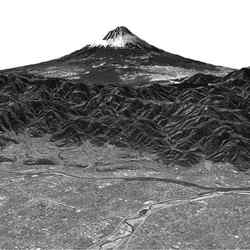
An image of Mt. Fuji, the first image acquired by ALOS. Image credit: JAXA Click to enlarge
This image of Mt. Fuji is the first data to be acquired by Japan’s recently launched Advanced Land Observing Satellite (ALOS) on 24 January 2006. ESA is supporting ALOS as a ‘Third Party Mission’, which means the Agency will utilise its multi-mission ground systems of existing national and industrial facilities and expertise to acquire, process and distribute data from the satellite to users.
Mt. Fuji ? Japan?s highest mountain (3 776 metres) ? is a volcano that has been dormant since its last eruption in 1707. It is located near the Pacific coast and straddles the prefectures of Yamanashi and Shizuoka about 100 kilometres west of Tokyo.
Detailed streets and rivers in the Kofu Basin are visible in the front of the image, and Motosu Lake, one of five lakes making up the Fuji Five Lake region, is in the centre right. The Fuji-Subaru road, which leads to the top of the mountain from Motosu Lake, can also be seen.
Motosu Lake, featured on the 5000 Yen note, is the westernmost of the five lakes, all of which were formed by lava flows, and has a circumference of 13 kilometres. The other four lakes are: Kawaguchi Lake, Yamanaka Lake , Sai Lake and Shoji Lake.
Thousands of people ascend Mt. Fuji every year, usually during July and August (the official climbing season) when there is no snow. The mountain hike is divided into ten stations, with paved roads going to the fifth station (around 1400 to 2400 metres above sea level).
The image data was acquired as part of the initial functional verification test since the satellite’s launch. One of ALOS’ three onboard instruments, the Panchromatic Remote-sensing Instrument for Stereo Mapping (PRISM), observed the mountain at 02:00 CET (10:30 Japan time) on 14 February 2006.
The PRISM is an optical sensor which has three independent optical systems for acquiring terrain and altitude data simultaneously, allowing for three-dimensional images with a high accuracy and frequency.
The other two instruments onboard ALOS are the Phased Array type L-band Synthetic Aperture Radar (PALSAR), a microwave radar instrument that can acquire observations through any weather conditions, and the Advanced Visible and Near Infrared Radiometer type-2 (AVNIR-2), designed to chart land cover and vegetation in visible and near-infrared spectral bands.
Original Source: ESA Portal
